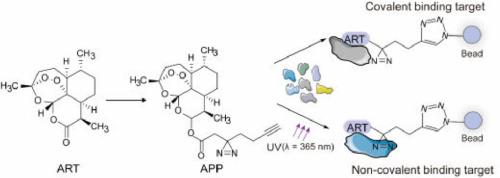Chinese Chemical Letters ( IF 9.4 ) Pub Date : 2023-03-05 , DOI: 10.1016/j.cclet.2023.108296
Peng Gao , Jiayun Chen , Peng Sun , Jianyou Wang , Huan Tang , Fei Xia , Liwei Gu , Huimin Zhang , Chen Wang , Yin Kwan Wong , Yinhua Zhu , Chengchao Xu , Jigang Wang

|
Present research on the antimalarial mechanisms of artemisinin (ART) is mainly focused on covalent drug binding targets alkylated by free radicals, while non-covalent binding targets have rarely been reported. Here, we developed a novel photoaffinity probe of ART to globally capture and identify the antimalarial target proteins of ART through chemical proteomics. The results demonstrated that ART can bind to parasite proteins by both covalent and non-covalent modification, and these may jointly contribute to the antimalarial effects. Our work enriches the research on the antimalarial targets of ART, and provides a new perspective for further exploring the antimalarial mechanism of ART.
中文翻译:

采用光亲和标记策略的化学蛋白质组分析确定了青蒿素的抗疟靶点
目前关于青蒿素(ART)抗疟机制的研究主要集中在自由基烷基化的共价药物结合靶点上,而非共价结合靶点的报道很少。在这里,我们开发了一种新型的ART 光亲和探针,通过化学蛋白质组学全局捕获和识别 ART 的抗疟靶蛋白。结果表明,ART可以通过共价和非共价修饰与寄生虫蛋白结合,这些可能共同有助于抗疟作用。我们的工作丰富了ART抗疟靶点的研究,为进一步探索ART抗疟机制提供了新的视角。































 京公网安备 11010802027423号
京公网安备 11010802027423号